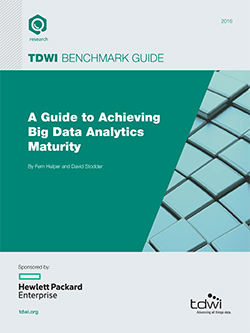
A Guide to Achieving Big Data Analytics Maturity (TDWI Benchmark Guide)
October 17, 2016
Today, many organizations are collecting increasing amounts of disparate data. In fact, many are collecting more than they can manage or analyze, yet they realize that big data and data analysis can provide an important strategic competitive advantage. According to TDWI research, interest is growing for big data solutions. In early 2014, TDWI created a big data maturity model to help organizations understand how their big data and analytics deployments compared with those of their peers and how they could develop a road map for advancing with analytics. Approximately 600 organizations have participated in the TDWI assessment, which objectively measures the maturity of a big data program across various dimensions key to deriving value from big data and big data analytics.
The Big Data Maturity Model assessment has approximately 50 questions across the five categories—organization, infrastructure, data management, analytics, and governance—that form the dimensions of the model. The maturity model itself consists of five stages of progression toward higher maturity—nascent, pre-adoption, early adoption, corporate adoption, and mature/visionary—with significant differences between each stage. As organizations move through these stages, we’ve seen them gaining more value from their analytics investments.
A Guide to Achieving Big Data Analytics Maturity (TDWI Benchmark Guide) builds on the model to discuss how organizations move through their big data analytics journey. It describes the stages of analytics maturity and what we’ve seen so far in the results of the assessment. To accompany the guide, we have identified numerous best practices that can help organizations move from one stage of maturity to the next, covered in a four-part series of TDWI Checklist Reports.
HPE is the sponsor of this material. By submitting your information you agree to be contacted by HPE on topics of interest.
Before deciding please review HPE’s privacy statement